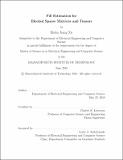| dc.contributor.advisor | Charles E. Leiserson. | en_US |
| dc.contributor.author | Xu, Helen Jiang | en_US |
| dc.contributor.other | Massachusetts Institute of Technology. Department of Electrical Engineering and Computer Science. | en_US |
| dc.date.accessioned | 2018-09-17T14:50:51Z | |
| dc.date.available | 2018-09-17T14:50:51Z | |
| dc.date.copyright | 2018 | en_US |
| dc.date.issued | 2018 | en_US |
| dc.identifier.uri | http://hdl.handle.net/1721.1/117816 | |
| dc.description | Thesis: S.M., Massachusetts Institute of Technology, Department of Electrical Engineering and Computer Science, 2018. | en_US |
| dc.description | This electronic version was submitted by the student author. The certified thesis is available in the Institute Archives and Special Collections. | en_US |
| dc.description | Cataloged from student-submitted PDF version of thesis. | en_US |
| dc.description | Includes bibliographical references (pages 69-71). | en_US |
| dc.description.abstract | Many sparse matrices and tensors from a variety of applications, such as finite element methods and computational chemistry, have a natural aligned rectangular nonzero block structure. Researchers have designed high-performance blocked sparse operations which can take advantage of this sparse structure to reduce the complexity of storing the locations of nonzeros. The performance of a blocked sparse operation depends on how well a particular blocking scheme, or tiling of the sparse matrix into blocks, reflects the structure of nonzeros in the tensor. Since sparse tensor structure is generally unknown until runtime, blocking-scheme selection must be efficient. The fill is a quantity which, for some blocking scheme, relates the number of nonzero blocks to the number of nonzeros. Many performance models use the fill to help choose a blocking scheme. The fill is expensive to compute exactly, however. This thesis presents a sampling-based algorithm called PHIL that efficiently estimates the fill of sparse matrices and tensors in any format. Much of the thesis will appear in a paper coauthored with Peter Ahrens and Nicholas Schiefer. We provide theoretical guarantees for sparse matrices and tensors, and experimental results for matrices. The existing state-of-the-art fill-estimation algorithm, which we will call OSKI, runs in time linear in the number of elements in the tensor. In contrast, the number of samples PHIL needs to compute a fill estimate is unrelated to the number of nonzeros in the tensor. We compared PHIL and OSKI on a suite of hundreds of sparse matrices and found that on most inputs, PHIL estimates the fill at least 2 times faster and often more than 20 times faster than OSKI. PHIL consistently produced accurate estimates and was faster and/or more accurate than OSKI on all cases. Finally, we found that PHIL and OSKI produced comparable speedups in parallel blocked sparse matrix-vector multiplication. | en_US |
| dc.description.statementofresponsibility | by Helen Jiang Xu. | en_US |
| dc.format.extent | 71 pages | en_US |
| dc.language.iso | eng | en_US |
| dc.publisher | Massachusetts Institute of Technology | en_US |
| dc.rights | MIT theses are protected by copyright. They may be viewed, downloaded, or printed from this source but further reproduction or distribution in any format is prohibited without written permission. | en_US |
| dc.rights.uri | http://dspace.mit.edu/handle/1721.1/7582 | en_US |
| dc.subject | Electrical Engineering and Computer Science. | en_US |
| dc.title | Fill estimation for blocked sparse matrices and tensors | en_US |
| dc.type | Thesis | en_US |
| dc.description.degree | S.M. | en_US |
| dc.contributor.department | Massachusetts Institute of Technology. Department of Electrical Engineering and Computer Science | |
| dc.identifier.oclc | 1051460433 | en_US |
